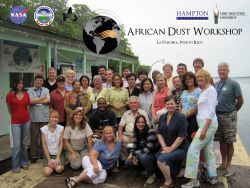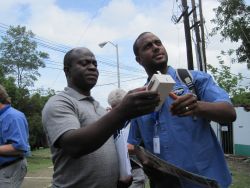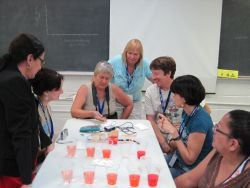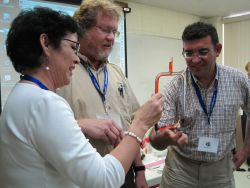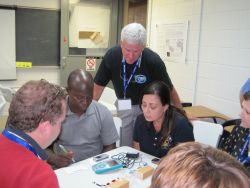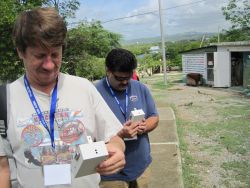Stars and STEM Stories
Aerosol Awareness Heightens at International African Dust Workshop
GLOBE Teachers from the United States, Mexico, Cameroon, and French Guyana gathered with other science educators and NASA Scientists in Mayaguez, Puerto Rico, from 20-25 June 2010 to learn innovative ways to incorporate GLOBE Protocols into classroom-based environmental studies. Hosted by NASA, GLOBE U.S. Partners Hampton University, and Fort Hays State University, and the Puerto Rico NASA Space Grant Consortium, the workshop provided participants with the tools they need to study airborne particles, known as aerosols, in their own neighborhoods in order to analyze how those aerosols affect local and global climate.
The workshop took place at a local Aerosol Robotic Network (AERONET) facility, a site dedicated to ground measurements of atmospheric aerosols. From June to July each year, a significant amount of dust travels over Puerto Rico from the Saharan Desert, creating optimal conditions for obtaining hands-on experience with measuring aerosols. Teachers measured aerosols using sun photometers in order to better understand the climatic effects of aerosols, including atmospheric mineral dust. Studies show that mineral particles transported over the ocean affect marine biochemistry by depositing iron into the ocean. This plays a role in neutralizing acid rain, affecting the life cycle of coral reefs and influencing sea surface temperatures that affect hurricane formation and intensity. In addition, changes in atmospheric dust aerosol loading could cause a change in the radiation balance and consequentially, surface temperatures.
"Research shows that the best way to interest students in science is to give them an opportunity to work with real science projects and scientists," expressed workshop director Dr. Dianne Robinson, Director of the Interdisciplinary Science Center (ISC) at Hampton University and GLOBE U.S. Partner from Hampton University in Virginia. One of the connections being made between students and scientists is an ongoing NASA study of African dust and its effect on climate and oceans. Learning the science behind this study allows teachers who attended the workshop to make lesson plans with real-life applications that explain why studying particles in the air is important.
Olga Kalashnikova, a research scientist at NASA who is studying African dust, explained that dust storms like those occurring in Africa can affect the Earth in many ways, such as changing soil moisture content, air and surface temperatures, rainfall and air quality. Dust in the atmosphere can also affect marine biochemistry. "When dust passes over water, it can affect marine ecosystems by supplying nutrients to the open ocean," explained Kalashnikova.
Workshop organizers sought to raise awareness about resources for educators, such as GLOBE data entry and MY NASA DATA, which allow teachers and students to observe satellite data and participate in taking and reporting environmental measurements. "NASA satellite missions provide educators with an excellent opportunity to involve their students in data collection and analysis," said Robinson.
The lessons and projects performed will go beyond just the workshop, as teachers conduct aerosol campaigns with their students, integrating Problem Based Learning (PBL) into lesson creation. The teachers who attended the workshop will develop lessons and investigations that allow their students to better understand the impact humans have on their environment and how that impact can affect other communities worldwide. "Strong partnerships and science projects evolve by giving teachers an opportunity to collaborate with one another, especially when it is done on a global level," added workshop coordinator Barbara Maggi, Outreach Director for the Center for Atmospheric Sciences at Hampton University. Since the conference, teachers continue to work directly with scientists to conduct local atmospheric investigations and make comparisons with other data collected by NASA satellites, which is publicly available through a program called MY NASA DATA.
Additional workshop instructors and lead teachers include Dr. Paul Adams, the lead workshop instructor, a GLOBE Partner and nationally recognized Science Educator at Fort Hays State University, NASA Goddard Scientist Ed Celarier, Hampton University Scientist Omar Torres, Portsmouth Public School Teacher Dan Borick, Norfolk Public School Teacher Paul Jones, GLOBE Mexico Teacher Gloria Faus, and GLOBE Puerto Rico Teacher Elizabeth Torres-Rodríguez. View workshop lessons on the MY NASA DATA website.
Learn more about the potentially detrimental effects of African Dust.
Plans are already underway to offer another African Dust Workshop to teachers from 20-25 June 2011.
19 November 2010






